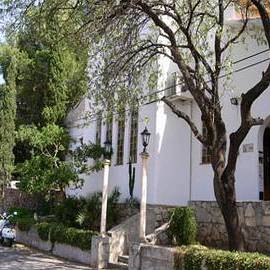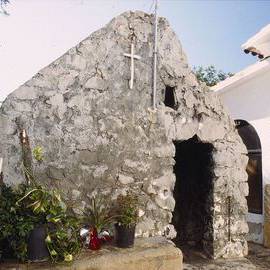Pare Pere Hermitage
INFORMATION OF INTEREST
This hermitage is connected to the life and works of the Venerable Friar Pere Esteve. Born in Dénia (1583-1658), in a house at calle Loreto which has a plaque to commemorate this, he thought to begin the Patron Saint celebrations of the “Santísima Sang”. Based on oral accounts in 1633, the residents of Dénia suffered a cholera epidemic. Friar Pere Esteve ordered to start the procession of the “Santísima Sang” image and afterwards, he blessed loaves of bread which he gave to the sick people, and as the tradition narrates, they were healed. He is considered as the holy man with the most devoted worship in Dénia and other towns in the district.
Friar Pere, known as “Pare Pere”, devoted a lot time to spiritual retreat, prayer and meditation where the hermitage which bears his name was built in homage to him. The traditional story never denied by the Dénia citizens states that Friar Pere Esteve used the stone shed to take refuge during a period. The shed is a vaulted structure built out of stone whose small size makes it uncomfortable to access.
Several recent studies by local historians testify that this structure was built as a cistern with the aim to collect rain water from the torrential runoffs of Mount Montgó in the 17th Century. The most certain aspect of the tradition is that the Franciscan friar used this shed to protect himself from harsh weather, since its construction was most probably prior to the occupation by Friar Pere Esteve.
The hermitage was built in the 20th Century. Its interior houses scenes (in ceramic images tiles) of the life and works of the Venerable Friar Pedro Esteve.
LOCATION
It is located on the northern side of Mount Montgó. It is approx. 600 m from the Hermitage of Sant Joan.
ITINERARY
Hiking Route:
- Difficulty: Low
- Duration: 45 min.
- Travel distance: 2.6 Km.
We begin our hike from Calle Diana, located in the Historiador Chabás Park in the direction of Montgó Natural Park. We reach a junction where we find a level crossing which we cross and continue on the Camí de Sant Joan in front of us. We pass a roundabout and take the second exit on the right as we continue on Camí de Sant Joan. From this point at approx. 850 m. we reach a fork in the road where we see a central islet with a large carob tree, which has a sign to the Hermitage attached to it. We take the road on the right as we follow Camí de Sant Joan. We travel approx. 600 m. until we reach the junction where we will take the road on the right called Camí del Assagador de Santa Llúcia. Soon we see a sign to the Hermitage on a telephone post. At 300 m, we encounter three roads, we take the one on the left and walk approx. 700 m uphill where we can see the sculpture dedicated to Pare Pere. We have reached the Hermitage.
Another option is to begin this route from the Plaza de Jaime I taking the Avda. del Montgó. At approx. 300 m, we reach a junction and must continue on the road in front of us called Camí Pou de la Muntanya. We cross a level crossing; starting from here, we will not deviate from the route for 1 km. We then arrive at a telephone cabin with a pharmacy sign; in this point, there is the first exit on the right which we must pass and then we take the next right, which is called the Carretera de la Colònia del Montgó. It is a very steep slope with a lot of shade by Mediterranean Pine trees which zigzags up the mountain until we reach the Hermitage. We travel approx. 800 m. up to an islet with a Pine tree and bicycle route sign, which we pass on our left, we walk an additional 100 m on the descending road and we then reach the Hermitage. Once the visit has concluded, we can take the opportunity to explore the “Via Crucis” (Stations of the Cross) which ascend Montgó and reward us with spectacular views of Dénia and its surroundings, which also invite us to enjoy the benefits of nature.
Camí Pou de la Muntanya
Tel.:



